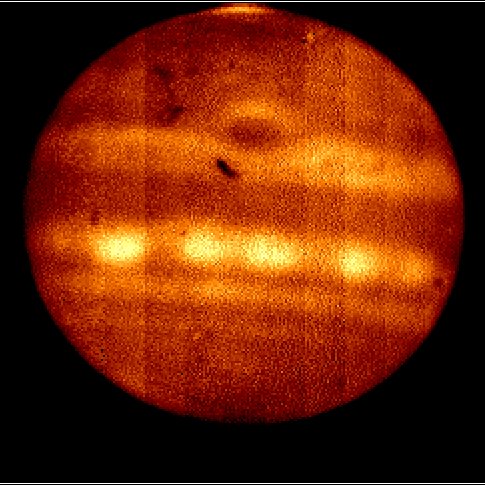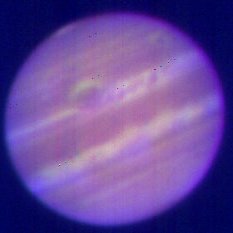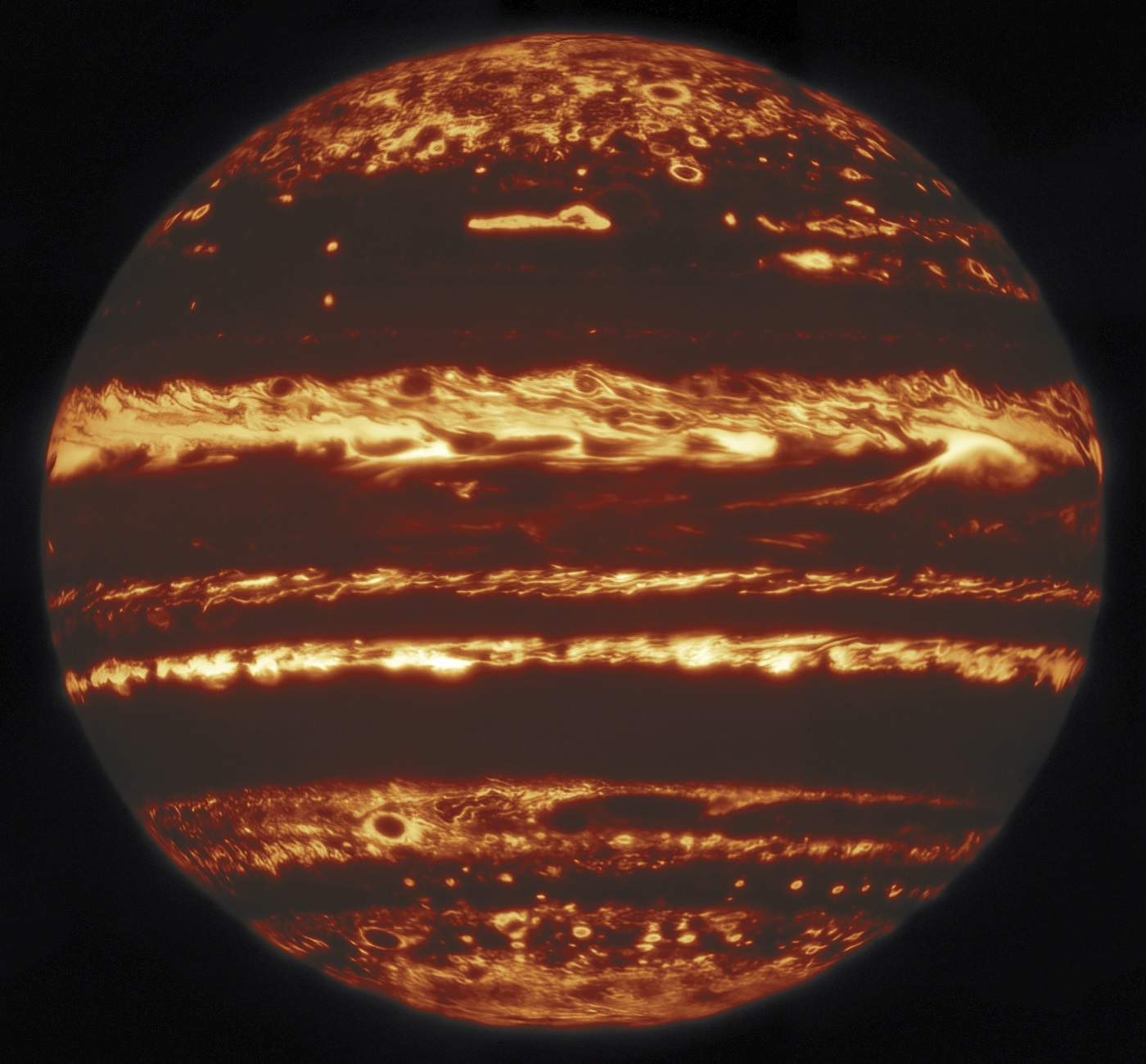This workshop, organised by Ricardo Hueso, is a continuation of previous meetings in Nice (2016) and London (2018), making stronger links between the Juno mission and the efforts by the amateur community to produce a near-continuous record of atmospheric activity on Jupiter. EPSC meetings have always had an amateur astronomy contribution, making it unique amongst planetary conferences - it's just a shame we were not able to meet again in person!
Image Processing for Jupiter
Christopher Go started proceedings on how to improve planetary image processing, describing his basic workflow and new techniques in processing. An exciting new development for planetary imaging is the Sony IMX462C back-illuminated CMOS chip, with very high sensitivity in the infrared, allowing them to capture very high-resolution methane band observations compared to the older IMX290M. Chris recommends "taking care of the little things" - seeing is the most important thing, which requires location, location, location. Local conditions can affect this, such as heat sources nearby (the warmth of the cement near his home), so Chris sprays the floor with water a few hours before imaging. He recommends watching the jetstream, using www.stormsurfing.com - if you're underneath it, it might not be worth going out imaging. Set up the OTA early and cool it down, using a cooling fan to reduce tube currents (e.g., Chris uses a vacuum cleaner!). The mirror needs to be locked after focussing to prevent focus shifts, never over-tightening the bolts, which would distort the mirror. Collimation needs to be done with a camera on, not with the eyepiece in, as a slight shift can occur. Chris is often asked what settings he uses for his camera, like exposure time and gain. These are immaterial, as he changes them depending on transparency and seeing - he uses the histogram close to 90% with FireCapture gain control. For high-quality captures, he emphasises the need to find the sweetspot of the system, use the fastest frame-rate possible, spend time to focus, don't be gain-shy, and capture a lot of data. For Jupiter, he focusses using Io or Europa.
Once he has the images, he performs derotation with WinJupos, which allows observers to stack beyond the time limit set by the rotation of the planet. This derotation is so good, Chris even uses it to process Hubble images, even though a typical Hubble image is only 15 minutes long. He uses something called Topaz Labs in Photoshop in methane-band images to pull out the details. Finally, Chris states that "the goal of planetary imaging, is not to acquire beautiful images, but to provide useful data."
Current Events on Jupiter
North Temperate Belt: John Rogers picks up the reigns with a review of current phenomena on Jupiter in 2020, and how it fits in with the long-term patterns of Jupiter's climate (cyclic patterns of events, sometimes regularly, sometimes irregularly). The most recent is the NTB south jet outbreaks, which usually occur every five years, but this one has erupted after only four years. One or more brilliant plumes erupts at the latitude of this jet, spreading a disturbance all around the planet. The first plume erupted on August 18th, the brightest feature on the planet in the visible and methane band, showing that it had punched up above the usual cloud deck. It has developed and expanded since, with two further plumes erupting in the weeks that follow at completely different longitudes. Animations over several weeks show the plumes moving eastward, with a wake of dark spots and chaotic regions behind it. One big dark spot - an anticyclonic vortex - appears roughly every five days. On September 1st, a second outbreak appeared, expanding in the same way as the first. On September 8th, a third one appeared. We expect each one to collapse and decay when it catches up with the tail of the previous one, and Shinji Mizumoto at ALPO-Japan has been doing some very careful tracking of this process. Plume 3 already appears to be disappearing, and we expect Plume 2 to disappear in late September, and Plume 1 by mid-October. The turbulent wakes them coalesce into a dark NTB south component, which will then become orange over time. Juno's PJ29 passed just a few days ago, but sadly did not cover the current outbreak.
North Tropical Domain: In the North Tropical Domain we observe NEB expansion events (where the brown belt expands northwards) every 3-5 years. The most recent one was in 2017, and a new event started in April 2020, possibly initiated in February from a bright rift around "White Spot Z" (a large white anticyclone). In the wake of the rifted region, some sections of the NEB were drifting northward. The belt had big dark patches, and some brighter cyclonic areas. By September the belt has expanded all the way around the planet. From here on, we expect a series of barges and Anticyclonic White Ovals (AWOs) all around the expanded northern NEB, but at the moment the NTB south outbreak could be disturbing this process.
Equatorial Zone: This typically-white zone has been vividly coloured over the past couple of years. This event began in 2018, peaked last year, but is still there today. As of this summer, it looks stable and distinct as an ochre belt. Maybe things are being brought up from the deeper atmosphere and "being cooked" by UV light to create the ochre colour.
South Tropical Domain: In the South Tropical Domain, the SEB is the only belt not undergoing any special cycles right now. It is unusually pale in the northern half, but there remains plenty of convective disturbance in the wake of the Great Red Spot, so no evidence of a fade any time soon. Its always possible that a new mid-SEB outbreak can occur at any time. Right now, some little vortices entering Red Spot Hollow are still pulling flakes out of the Red Spot, continuing the activity seen in 2019. It's still happening, and was observed again this month. The GRS has begin shrinking again this year, even though the flaking events haven't been quite so impressive, so will this be a stable decline or will it recover again?
Finally, the South Temperate Domain, which consists of structured sectors that appear and propagate around the planet on an otherwise blank domain. There's always two or three of these, one at the moment adjacent to Oval BA, and another at the following end of the STB spectre. We are expecting a new structure to arise preceding Oval BA, arising from cyclonic vortices. The appearance of "Clyde's Spot" from the small white spot in STB latitudes might be a precursor of this, and was observed by JunoCam during PJ27. This short-lived plume left a darker spot that has continued to be turbulent, and maybe the dark spot will evolve into a new structured sector.
Juno and JunoCam
Glenn Orton from JPL joined from California, mentioning that they finally have clear air after the winds have shifted from the Bobcat fire, and the Mount Wilson observatory has been saved. Glenn's role on the Juno mission was to provide ground-based observations to support the mission. These are needed to improve the spatial coverage over the globe where Juno is not observing; to provide context in time to track the evolution of features; to provide spectral coverage in ranges that are not covered by Juno instrumentation, and to provide simultaneous coverage of multiple components of the jovian system (e.g., Io).
The nominal mission ends at PJ34, in June 2021, but a proposal will soon be submitted for an extended mission, with a maximum of 76 orbits up to May 2025, providing high resolution coverage of Jupiter's northern hemisphere and pole, with multiple flybys of Io, Europa, Ganymede, as well as a characterisation of the ring system. Supposedly we'll know the outcome towards the end of this year. Very late on, there'll also be opportunities for radio occultations of the jovian atmosphere. One caveat is that we'll be going into a treacherous part of the magnetosphere, an increasing challenge for the spacecraft.
Candy Hansen emphasises that the Juno mission also has artists involved, and not just scientists and engineers. JunoCam, a push-frame imager built by Malin Space Science Systems, is on the payload to allow the public to participate in a planetary mission, and the great science is a bonus. At the closest point, JunoCam is observing the storms from just a few thousand kilometres up. JunoCam collects data for only 2 hours out of a 53-day orbits, so amateur observations are essential to fill in the gaps. Lighting is everything to an imaging experiment. When Juno arrived, the orientation of the orbit meant we were looking at the terminator region. As time went on, it became more challenging to observe, but now the orbit is evolving, and we'll come over onto the dusk side of Jupiter, allowing us to get great images with nice shadows. The orbit is evolving into a more southerly orientation, getting close to the north pole, with a long period to image the southern hemisphere (albeit at worsening resolution). The closest approach will be at a latitude of 28N by the nominal end of mission on PJ34, reaching 63N by the end of PJ75. For a little outreach camera, there's an awful lot of science being done.
To monitor the health of the camera, one image is taken every PJ pass with all the same settings, so we have a record as the orbit evolves to show how the camera is changing. Up to now, there is no sign of permanent damage, just a little more radiation noise, so they expect to survive right to the end of the mission.
Kevin Gill then described the image processing pipeline he uses for JunoCam images. Kevin is one of many people who process these images. He's an engineer at JPL, but does the processing on an amateur basis. The raw data has long framelets, used to produce the map-projected colour images. Kevin takes the raw framelets, as it provides better options for colour calibration. His pipeline produces maps, which then inform wide-angle perspective views, cylindrical projected detailed shots with some enhancening and sharpening; fish-eye composites (ultra-wide angle views that makes it look like you're seeing the full disc). His code also outputs meshes for 3D programmes like Blender. He's also working on stereographic images, as best he can given the dynamic nature of Juno's orbit and the interval between observations, as well as fly-over movies. The automated pipeline is open source and can be found on his github, uses ISIS3 and Spice. He then uses manual processing for the reprojection and combination if he's making a composite of multiple observations, using the ISIS3 suite. Blender, Photoshop, Topaz Denoise (very carefully!) and Lightroom are then used to produce his output products. This not a scientific approach, but provides a visually pleasant view (Ed: that's an understatement!).
The Value of Long Term Monitoring of Jupiter
Finally, Arrate Antunano gives a presentation on how the data you're taking today might be of value to those researching Jupiter in the decades to come. Different planets display diverse cyclic activity in their weather and climate patterns. Jupiter has dramatic planetary-scale disturbances that completely alter the planet's appearance. Most studies deal with just snapshots of observations, usually as a result of one phenomenon that captures the imagination at the time. But what is the big picture here? How do things change in the long term? How cyclic are these events? Are there correlations between different events?
 |
Long-term monitoring of Jupiter's atmosphere, highlighting the expansion and contraction of the north equatorial belt - credit: Fletcher et al. (2017)
|
Ground-based observations are a goldmine for researchers. At infrared wavelengths, we have around 40 years of observations available since the early 1980s, providing great temporal coverage. Checking the
Planetary Virtual Observatory and Laboratory (PVOL), the amateur observations span 2000 to 2020, and even older observations are present in the ALPO-Japan directory. These long-term observations at multiple wavelengths allows them to characterise temperature, composition, and aerosol changes.
Examples of these cyclic activities include the cloud-clearing events at the equator, where the equator brightened at 5 microns with a period of 7-years or so. This brightening h appens at the same time as the visible coloration events at the equator. The aerosol opacity decreases at the 400-600 mbar level, where the ammonia clouds are. However, we didn't see any change in ammonia or temperature, so this rejects the idea that the cloud-clearing is due to warming and evaporation of clouds. Maybe changes in the deep ammonia gas are responsible, but this is something that Juno has not yet investigated. Also using 5-micron data, some changes in the bands are observed to be anticorrelated, particularly between changes in brightness of the NEB and SEB. Finally, looking at 7.9 microns, which senses Jupiter's stratospheric temperatures, reveals how Jupiter's equatorial stratospheric winds change with time. We've known this for 30 years, but new results published in Nature Astronomy show that Jupiter's equatorial stratospheric oscillation has been disrupted twice, completely switching into a new period, and these changes coincide with substantial disturbances in the deeper atmosphere. This is unexpected, and hasn't been observed on Earth or Saturn, which have similar equatorial stratospheric oscillations.
The long-term Jupiter observations are critical for this exploration of natural jovian cycles, and Arrate would like to continue this study with reflected sunlight observations, to understand the vertical extent of the events and their interconnectivity with the deeper atmosphere, so that we can maybe predict these events in advance to be ready with our telescopes.
 |
| The Pro-Am community at the 2018 meeting at the Royal Astronomical Society in London. |















